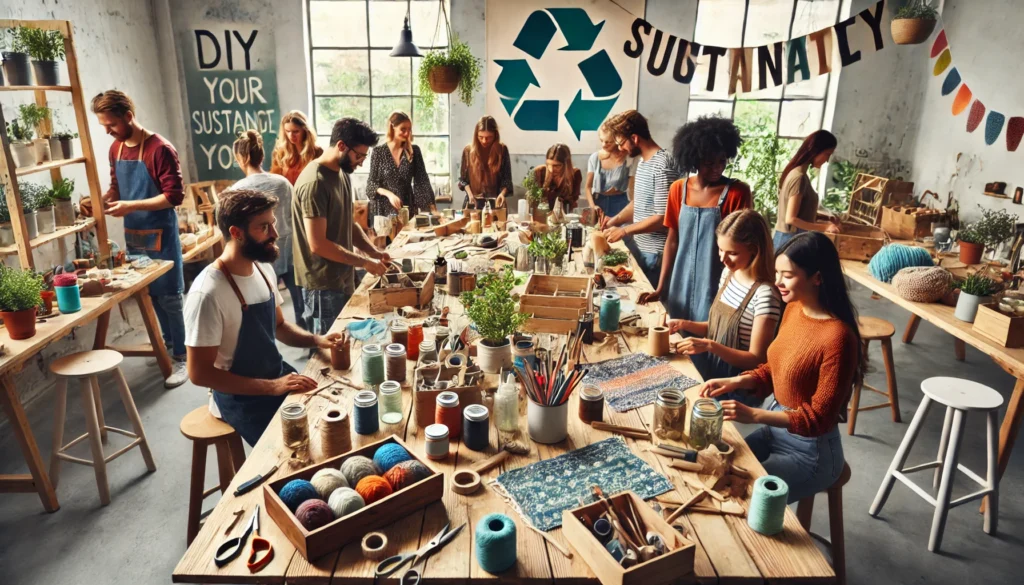Embrace Sustainability with Creative DIY Projects
In today’s fast-paced world, embracing sustainability is no longer a trend but a necessity. Sustainable DIY projects are a great way to repurpose and reuse items that might otherwise end up in a landfill. Adopting this mindset can help you reduce waste, save money, and contribute to a healthier planet. In this article, we’ll dive into inspiring ideas and practical tips to help you repurpose and reuse like a pro.

The Art of Repurposing: Transform Trash into Treasure
Repurposing is the art of giving new life to old or discarded items. It’s about seeing the potential in what others might consider waste. By transforming everyday objects into something functional or beautiful, you not only extend their life but also add a personal touch to your space.
For example, take that dusty stack of mason jars in your cupboard. Add a little creativity, and those jars can become trendy organizers for your craft supplies or chic vases for a rustic-themed centerpiece. Repurposing doesn’t only save resources but also unleashes your creativity and gives your home a unique charm.
Basic Tools for Sustainable DIY Projects
Before you start working on your next project, there are some essentials that will be required. Some of the basics include:
A hot glue gun for assembling and attaching materials.
Sandpaper for smoothing surfaces.
Non-toxic paint and brushes for adding a splash of color.
A sewing kit for fabric-based projects.
Scissors and cutting tools for precision work.
Equipped with these tools, you can tackle almost any DIY project while staying eco-friendly.
Creative Ideas to Get Started
Old furniture doesn’t need to end up in the dump. Sand an old wooden chair down, and slap on some new eco-friendly paint with a splash of color by adding some stenciled designs to give it new life. Likewise, that old, battered dresser gets turned into a piece of art using just a splash of paint and a little imagination.
Reuse Textiles and Clothing
Fashion can be wasteful, but you can make a difference by repurposing old clothes. Turn a pair of worn jeans into a trendy tote bag or transform an old t-shirt into reusable cleaning cloths. With basic sewing skills, you can create functional and stylish items while reducing textile waste.
Create Home Décor from Everyday Items
Look around your home for items that can be upcycled into decorative pieces. Wine corks can be turned into coasters or wall art. Tin cans can become charming planters for your indoor garden. Even an old ladder can be repurposed into a chic shelving unit with a touch of paint and some adjustments.
Reuse Glass Containers
Glass containers are incredibly versatile and can be reused in countless ways. Use them to store dry goods in your pantry, as candle holders, or even as terrariums for small plants. By reusing glass, you reduce the demand for new production and minimize waste.
Upcycling for the Outdoors
The great DIY journey towards sustainability does not necessarily have to take place indoors. Extend your creativity outdoors by using upcycled materials for your garden or patio. For instance, old wooden pallets can become a vertical garden or outdoor seating arrangement. Tires, which would otherwise be regarded as waste, can be repurposed as attractive planters or even an amusing swing for kids.
Moreover, broken pots and ceramics can be used to make pretty garden mosaics or be put as a drainage layer of newly installed planters. So, think out of your box; beautify your outdoor spaces with minimal amounts of waste.
The Role of Community in Sustainable DIY
Sustainability thrives on collaboration. Connecting with your local community can give you access to resources, materials, tools, and ideas shared from one person to another. Wonderful sources of free or very inexpensive materials in community swap events or online groups dedicated to upcycling and DIY. There is also an opportunity to learn from others and to spur each other into wanting more elaborate projects.
Hosting DIY workshops or attending one can also amplify the effort in a much wider aspect. Sharing knowledge and skills will allow more people to adopt the next sustainable practices leading to creating a ripple effect which saves the environment.
Benefits of Sustainable DIY Projects
Sustainable DIY projects are not only satisfying for personal fulfillment but also create a ripple effect on the environment and your community. The reuse and repurposing of items reduce the demand for new resources and, consequently, your carbon footprint. Moreover, you encourage others to think creatively about sustainability.
Another important benefit is financial. Instead of spending money on new stuff, you use what you have or source your materials cheaply. DIY projects also serve as a therapeutic outlet where you can unwind and channel your creativity into something meaningful.

Tips for Sustainable DIY Success
Start small: If you are a first-timer at DIY, begin with simple projects and work your way up from there.
Source Materials Responsibly: Look for second-hand items, thrift stores, or community swaps for supplies.
Use Eco-Friendly Products: Opt for non-toxic paints, adhesives, and other materials to keep your projects sustainable.
Stay Organized: Keep your tools and materials in order to make the process smoother and more enjoyable.
Get Inspired: Explore blogs, social media platforms, and DIY communities for fresh ideas and techniques.
Inspire a Greener Future with DIY Projects
Sustainable DIY projects signify more than an activity; they symbolize a movement towards a conscious and responsible life. They contribute to greening the earth by rejuvenation and reuse, leaving behind examples for others to follow along. Whether you’re upcycling old furniture or transforming old clothes into something new or just making something unique for decorations, every DIY project is the step towards sustainability. So, roll up your sleeves and start your journey into the world of sustainable DIY. Let your creativity flow, and remember: the possibilities are endless when you think out of the box.